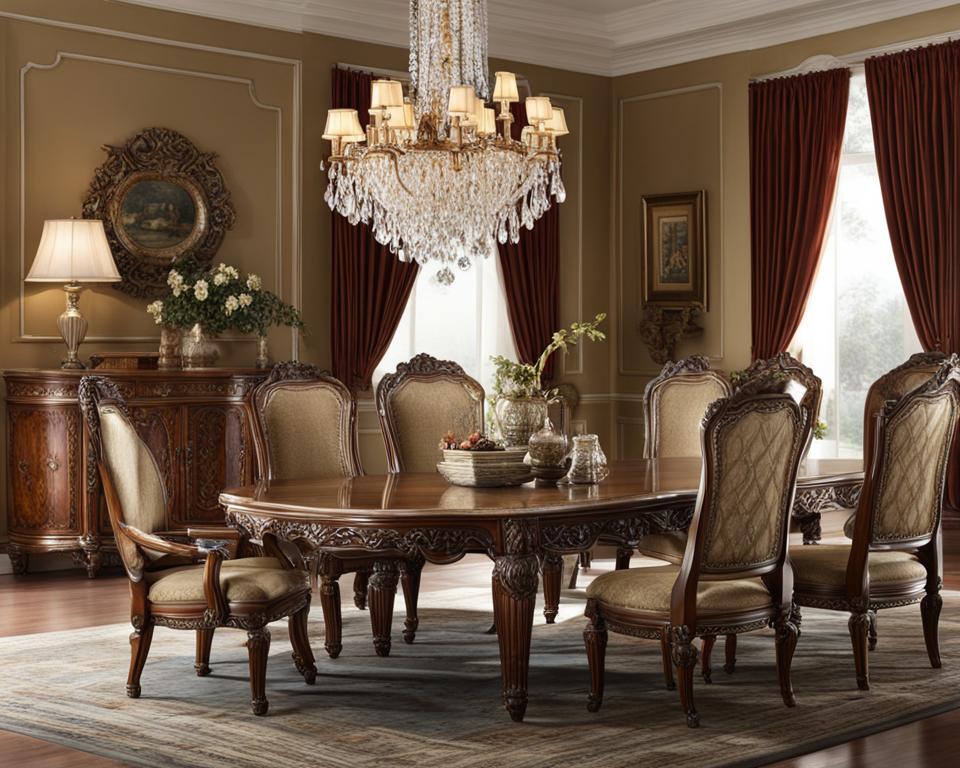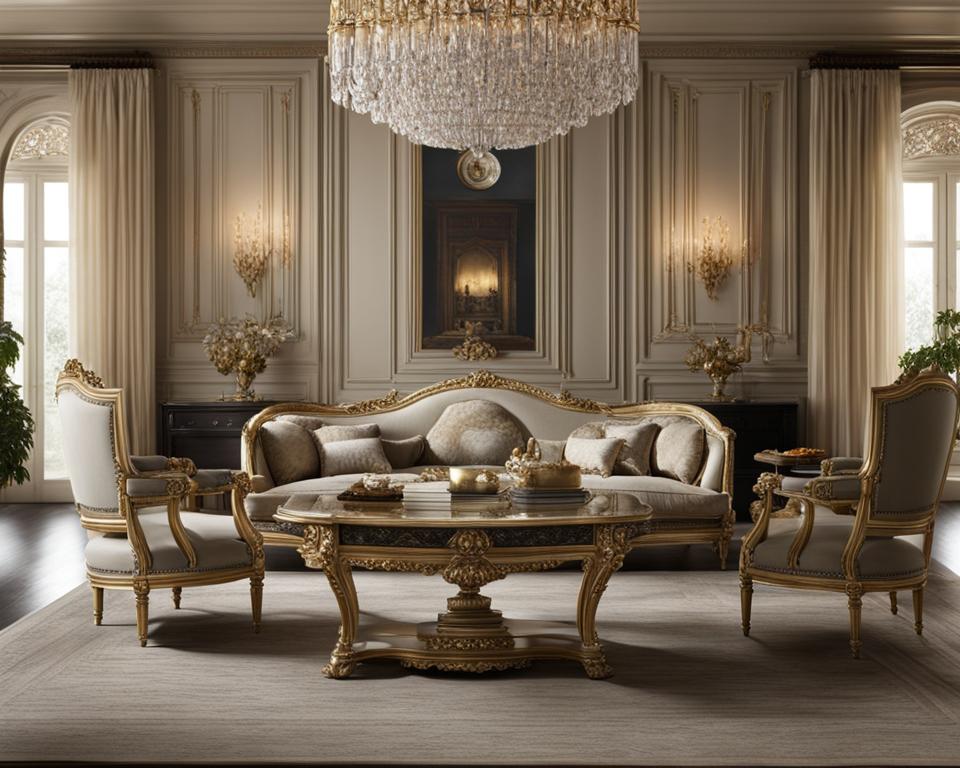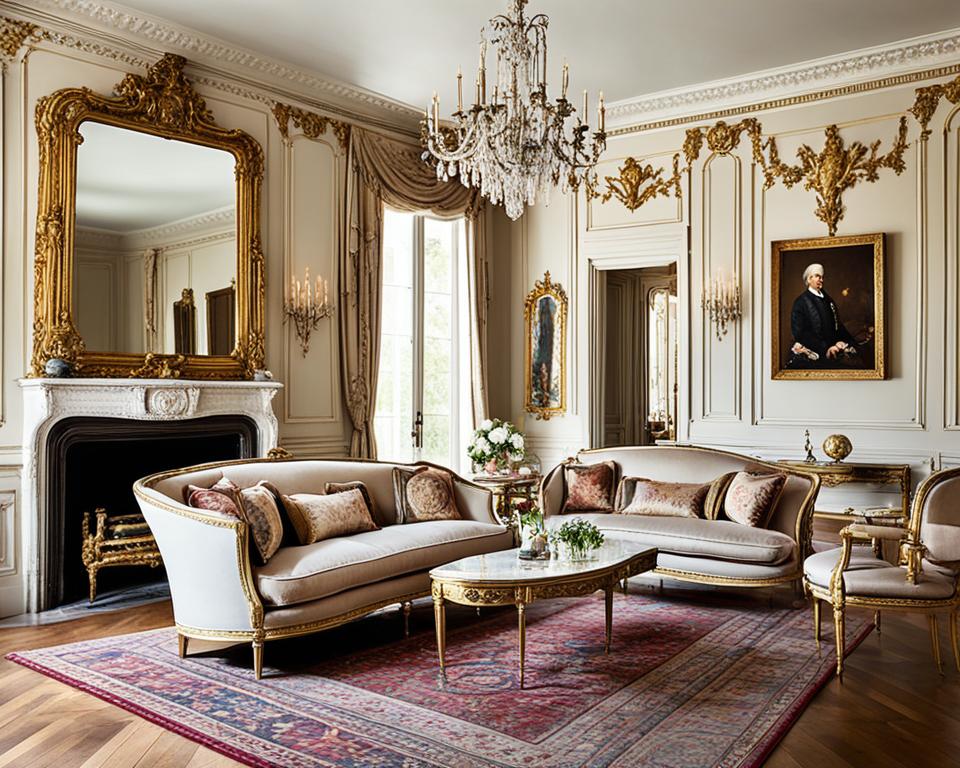
Louis XVI antique furniture is renowned for its elegance and timeless appeal. This neoclassical style emerged in late 18th century France, reflecting the tastes of the period’s monarch, Louis XVI, and his queen, Marie Antoinette. With its clean lines, precise detailing, and refined color palette, Louis XVI furniture exudes sophistication and grandeur.
Key Takeaways:
- Louis XVI furniture is characterized by simple yet elegant design.
- It emphasizes clean lines, right angles, and classical motifs.
- The style reflects the influence of neoclassicism and the historical context of the French Revolution.
- Louis XVI furniture features ornate detailing and the use of luxurious materials.
- Incorporating Louis XVI furniture in your home decor adds an element of historical richness and enduring elegance.
The History and Influence of Louis XVI Style
The Louis XVI style of furniture emerged during the reign of Louis XVI, the last monarch of pre-revolutionary France. Influenced by the Neoclassical movement and its inspiration from ancient Greek and Roman design, Louis XVI style furniture reflects the monarchy’s attempt to establish stability during a time of political unrest. Despite the excesses of the monarchy and mounting societal tensions, this elegant style continued to flourish and remains a symbol of timeless sophistication.
The Neoclassical movement, which originated in the mid-18th century, sought to revive the classical art and architecture of ancient Greece and Rome. It emphasized clean lines, geometric shapes, and classical motifs, a departure from the ornate and elaborate styles that preceded it. Louis XVI style furniture embraced these principles, showcasing a sense of simplicity and refined elegance.
The French Revolution, which began in 1789, had a profound impact on the Louis XVI style. It ultimately led to the downfall of the monarchy, including Louis XVI himself. However, the neoclassical influence of the style persisted amidst the revolutionary fervor. The revolutionaries themselves embraced Neoclassicism, considering it a symbol of the Enlightenment and a rejection of the opulence associated with the monarchy.
Despite the political change, Louis XVI style furniture continued to be appreciated and sought after. Wealthy individuals and institutions were still drawn to its elegance and classical references. The style’s clean lines, delicate detailing, and refined color palettes perfectly suited the changing tastes of the time.
The enduring influence of Louis XVI style extends beyond 18th century France. Today, it remains an important reference for interior designers and collectors worldwide who appreciate its timeless elegance. Its influence can be seen in various design movements and aesthetics, from traditional to contemporary.
“Louis XVI style furniture is a true testament to the enduring appeal of Neoclassicism. Its blend of simplicity, sophistication, and classical references continues to captivate and inspire.”
Key Influences of Louis XVI Style:
- Neoclassical movement
- Ancient Greek and Roman design
- The pursuit of simplicity and elegance
- The French Revolution
Distinctive Features of Louis XVI Style:
- Clean lines and geometric shapes
- Classical motifs and references
- Refined color palettes
- Delicate detailing
- Use of luxurious materials
Enduring Legacy
The elegance and charm of Louis XVI style furniture continue to make it a popular choice for those seeking to create a sophisticated and timeless interior. Its harmonious blend of simplicity, classical elements, and refined craftsmanship adds a touch of grandeur to any space, whether it be a traditional mansion or a modern apartment.
By incorporating Louis XVI style furniture, you can infuse your home with the rich history and enduring elegance of this iconic design movement. Its timeless allure stands as a testament to the enduring influence of Neoclassicism and the lasting impact of French design on the world stage.
Characteristics of Louis XVI Antique Furniture
Louis XVI antique furniture embodies the essence of Neoclassical design with its distinct characteristics that reflect the influence of ancient Greek and Roman architecture. The furniture showcases a harmonious blend of ornate detailing, precise geometric shapes, and a refined color palette, creating an air of elegance and sophistication.
Straight Lines and Symmetry
The hallmark of Louis XVI furniture is its emphasis on straight lines and symmetry, a departure from the curvilinear forms of the preceding Rococo style. This commitment to precise geometric shapes creates a sense of order and balance in the furniture’s overall design.
Ornate Detailing
Louis XVI furniture is renowned for its ornate detailing, displaying intricate carvings and reliefs that showcase the craftsmanship and artistry of the era. From delicate floral motifs to symbolic designs, the furniture’s decorative elements are meticulously crafted to add richness and beauty to each piece.
“The intricate detailing of Louis XVI furniture elevates it to a level of exquisite luxury, making it a true work of art.”
Luxurious Materials
The use of luxurious materials further enhances the allure of Louis XVI furniture. Fine woods such as mahogany and oak are carefully selected for their quality and richness. These materials serve as a canvas for the intricate detailing and contribute to the furniture’s overall opulence and refinement.
Light and Refined Color Palette
The color palette of Louis XVI furniture is characterized by light and delicate hues. The furniture often features light-colored upholstered fabrics, such as silk or damask, that exude elegance and sophistication. Delicate painted finishes on wood add a touch of softness and grace to the overall aesthetic.
Fluted Legs and Tapered Columns
Fluted legs and tapered columns are common features of Louis XVI furniture, adding to its sense of classical elegance. These architectural details showcase the mastery of the craftsmen and create visual interest and depth in the furniture’s design.
Louis XVI Furniture Designers
Louis XVI furniture owes its exquisite craftsmanship and elegant design to the talented artisans and cabinet-makers of the time. Two prominent designers who made a significant impact on the style and craftsmanship of Louis XVI furniture were Jean-Henri Riesener and Georges Jacob.
Jean-Henri Riesener
Jean-Henri Riesener was a renowned designer who held royal patronage during the reign of Louis XVI. He was highly regarded for his exceptional skill in marquetry and ornamentation. Riesener favored the use of exotic materials, such as tulipwood, rosewood, and satinwood, to create intricate and captivating designs. His craftsmanship and attention to detail elevated Louis XVI furniture to new heights of opulence and sophistication.
Georges Jacob
Georges Jacob was another influential designer who played a pivotal role in shaping the style of Louis XVI furniture. He was known for his innovative designs and incorporation of unique motifs into his pieces. Jacob introduced new elements such as triangles and rosettes, adding a touch of modernity to the traditional Louis XVI style. His groundbreaking work pushed the boundaries of design and further enhanced the elegance of Louis XVI furniture.
Jean-Henri Riesener and Georges Jacob were true masters of their craft, leaving a lasting legacy in the world of furniture design during the Louis XVI era. Their exquisite creations continue to captivate collectors and enthusiasts alike, showcasing the timeless beauty and meticulous craftsmanship of Louis XVI furniture.
| Designer | Design Style | Notable Contributions |
|---|---|---|
| Jean-Henri Riesener | Opulent marquetry and ornamentation | Used exotic materials, held royal patronage |
| Georges Jacob | Innovative designs with modern motifs | Pioneered the use of triangles and rosettes |
These talented designers left an indelible mark on the world of furniture design, ensuring that Louis XVI furniture remains a symbol of elegance and refinement to this day.
Louis XVI Furniture Materials
Louis XVI furniture was crafted using a variety of high-quality materials. The choice of materials played a crucial role in the opulence and refinement of these exquisite pieces. Common woods such as mahogany, walnut, and oak were prominently used in the construction of Louis XVI furniture.
The skilled artisans and cabinet-makers of the time employed these fine woods to showcase their expertise in marquetry and parquetry techniques. These intricate woodworking techniques allowed for the creation of stunning patterns and designs on the furniture’s surfaces, adding another layer of visual interest to the pieces.
In addition to the rich wood, Louis XVI furniture also featured ormolu mounts. These mounts, made of gilded bronze, served as decorative accents that elevated the luxuriousness of the furniture. The ormolu mounts were carefully crafted and added a touch of glamour and sophistication to the overall design.
The combination of the fine woods, delicate marquetry, and gilded ormolu mounts exemplified the attention to detail and craftsmanship that defined Louis XVI furniture. It was through the thoughtful selection and skillful use of these materials that the furniture achieved its timeless elegance and enduring appeal.
Louis XVI Furniture Symmetry and Balance
Louis XVI furniture is renowned for its meticulous attention to symmetry, order, and balance. The pursuit of visual equilibrium is a key characteristic of this elegant style. The furniture often showcases symmetrical arrangements of ornamentation, creating a harmonious and balanced aesthetic.
The use of straight lines and precise geometric shapes further enhances the overall sense of harmony and sophistication. From the clean angles of chairs and tables to the structured frames of cabinets and armoires, Louis XVI furniture exemplifies a commitment to geometric precision.
The incorporation of mirrored patterns on case pieces adds another layer of balance and symmetry, reflecting light and creating an illusion of space. This careful attention to detail contributes to the timeless elegance that defines Louis XVI furniture.
This focus on symmetry and balance in Louis XVI furniture is rooted in the Neoclassical movement that inspired the style. Neoclassicism drew inspiration from ancient Greek and Roman design, which emphasized order and proportion. By embracing these principles, Louis XVI furniture achieves a sense of beauty and harmony that can enhance any interior space.

“The symmetrical arrangement of ornamentation and the use of straight lines and geometric shapes in Louis XVI furniture create a sense of visual equilibrium and timeless elegance.”
Louis XVI Furniture: A Timeless Elegance
Louis XVI furniture exudes a timeless elegance that transcends trends and remains highly coveted today. Its simple yet sophisticated design complements a variety of interior design styles, from modern to traditional. The furniture’s intricate detailing, precise craftsmanship, and refined color palette make it a valuable addition to any home. Whether as a focal point or as a complement to other pieces, Louis XVI furniture brings a sense of history, grandeur, and sophistication to any space.
With its clean lines and exquisite ornamentation, Louis XVI furniture adds a touch of luxury and refinement to any room. The style’s emphasis on symmetry and balance creates a sense of visual harmony that is both pleasing to the eye and timeless in its appeal. The use of high-quality materials, such as mahogany and oak, further enhances the furniture’s enduring durability and elegance.
Whether you prefer a classic, opulent look or a more contemporary aesthetic, Louis XVI furniture seamlessly integrates with various interior design styles. The versatility of its design allows for mixing elements of different eras, creating a juxtaposition that adds depth and character to your space. Pairing a Louis XVI armchair with sleek modern decor or incorporating a Louis XVI-inspired console table in a minimalist setting adds an element of sophistication and historical richness.
Not only does Louis XVI furniture contribute to the visual appeal of a room, but it also tells a story. Each piece carries the rich history and grandeur of the 18th century French monarchy. The intricate carvings, elaborate motifs, and gilded accents are a testament to the skilled craftsmanship of the artisans who created them. Owning a piece of Louis XVI furniture allows you to bring a slice of history into your home, connecting you with the elegance and refinement of a bygone era.
Whether you’re furnishing a living room, dining room, or bedroom, incorporating Louis XVI furniture into your interior design scheme adds a touch of luxury and sophistication. Its enduring elegance and timeless design make it a valuable investment that will enhance the beauty and grandeur of your home for years to come.
Incorporating Louis XVI Furniture in Your Home
Louis XVI furniture, with its timeless elegance and historical richness, can seamlessly be incorporated into your home decor. Whether you appreciate a mix of styles or want to create unique juxtapositions, Louis XVI furniture offers endless possibilities to enhance your living space.
One way to incorporate Louis XVI furniture is by pairing it with modern art and sculpture. The juxtaposition of ornate French furniture and contemporary artwork creates a striking visual contrast that adds depth and intrigue to your home. The fusion of old and new creates a dynamic and eclectic atmosphere that showcases your personal style and creativity.
If you prefer a more cohesive design scheme, you can integrate Louis XVI pieces into a contemporary or eclectic setting. The clean lines and elegant details of Louis XVI furniture complement modern aesthetics, creating a harmonious balance between traditional and contemporary elements. By carefully selecting and curating your pieces, you can achieve a cohesive and sophisticated look that is uniquely yours.
In addition to mixing styles, Louis XVI furniture also adds historical richness to any space. Each piece tells a story of craftsmanship and artistry from a bygone era. The intricate carvings, gilded accents, and exquisite finishes embody the opulence and grandeur of the Louis XVI period. By incorporating these historical elements into your home, you infuse it with a sense of refinement and sophistication that stands the test of time.

Where to Find Louis XVI Antique Furniture
If you are looking to find Louis XVI antique furniture, there are various sources available. Antique dealers and specialized showrooms offer a wide selection of authentic pieces. One notable showroom is Lorfords, which has a large collection of Louis XVI furniture, including dining tables, armoires, and giltwood chairs. Their Tetbury showroom and hangars at Babdown Airfield provide a unique opportunity to browse and select from a range of Louis XVI pieces.
If you’re passionate about owning a piece of history and want to experience the beauty and craftsmanship of Louis XVI furniture firsthand, Lorfords is an excellent choice. With their extensive collection and expertise, you’ll be able to find the perfect Louis XVI piece to complement your home decor.
Conclusion
The enduring elegance of Louis XVI antique furniture is a testament to the timeless appeal of Neoclassical design. With meticulous craftsmanship, attention to detail, and a refined aesthetic, Louis XVI furniture continues to captivate collectors and interior designers. Its graceful lines and intricate embellishments showcase the exquisite artistry of the era, making it a cherished addition to any home.
By incorporating Louis XVI pieces into your interior decor, you can create a space that exudes sophistication, history, and a sense of grandeur. Whether as a focal point or an ensemble, Louis XVI furniture brings an aura of opulence to any setting. Its enduring elegance effortlessly complements a variety of design styles, allowing for seamless integration into both traditional and modern interiors.
From exquisite dining tables and ornate armoires to gilded chairs, Louis XVI antique furniture offers a touch of enduring elegance that remains unparalleled. Its Neoclassical design, inspired by the ancient Greeks and Romans, evokes a sense of timeless beauty and harmony. Embrace the grace and refinement of Louis XVI furniture to transform your home into a sanctuary of classic allure and timeless grandeur.
FAQ
What is Louis XVI antique furniture?
Louis XVI antique furniture is a neoclassical style that emerged during the late 18th century in France. It is characterized by clean lines, right angles, and classical motifs, and it features luxurious materials, intricate detailing, and a light and refined color palette.
When did Louis XVI style furniture originate?
Louis XVI style furniture emerged during the reign of Louis XVI, the last monarch of pre-revolutionary France, in the late 18th century. It was heavily influenced by the Neoclassical movement, which drew inspiration from ancient Greek and Roman design.
What are the characteristics of Louis XVI antique furniture?
Louis XVI antique furniture is known for its commitment to Neoclassical principles. It features straight lines, symmetry, precise geometric shapes, and ornate detailing, including carved motifs and gilded bronze accents. The color palette is light and refined, and it often uses luxurious materials such as mahogany and oak.
Who were the notable designers of Louis XVI furniture?
Jean-Henri Riesener and Georges Jacob were two renowned designers of Louis XVI furniture. They played a significant role in shaping the style and craftsmanship of this period. Riesener favored exotic materials for marquetry and ornamentation, while Jacob incorporated innovative designs and motifs into his work.
What materials were used in crafting Louis XVI furniture?
Louis XVI furniture was crafted using high-quality woods such as mahogany, walnut, and oak. These woods were often utilized for marquetry and parquetry techniques to create intricate patterns and designs. The furniture also featured ormolu mounts, which are gilded bronze accents that added a luxurious touch.
Why is symmetry important in Louis XVI furniture?
Louis XVI furniture emphasizes symmetry to create a sense of visual equilibrium and harmony. The use of straight lines, geometric shapes, and mirrored patterns on case pieces contributes to the overall balanced and refined aesthetic that defines this style.
Can Louis XVI furniture be incorporated into different interior design styles?
Yes, Louis XVI furniture can be seamlessly incorporated into various interior design styles, from modern to traditional. Its timeless elegance allows for mixing styles and creating unique juxtapositions, adding depth and character to any space.
Where can I find Louis XVI antique furniture?
If you are looking for Louis XVI antique furniture, you can find a wide selection at antique dealers and specialized showrooms. One notable showroom is Lorfords, which offers a range of Louis XVI furniture, including dining tables, armoires, and giltwood chairs.
What makes Louis XVI antique furniture timeless?
Louis XVI antique furniture exudes a timeless elegance that transcends trends. Its simple yet sophisticated design, precise craftsmanship, and refined color palette make it a valuable addition to any home, bringing a sense of history, grandeur, and sophistication to any interior space.
